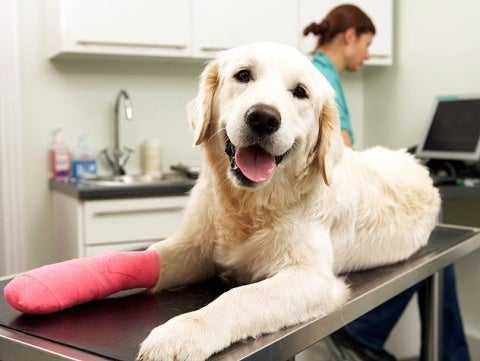How to Care for Your Pet’s Bandage, Splint or Sling

If your pet is recovering from a condition that requires a bandage, sling or splint, proper home care is imperative to your pet's recovery. Complications are much more likely to occur in pets that do not receive proper home care and monitoring.
Splints, slings and bandages can potentially cause very serious problems if they:
- become damaged
- slip
- twist
- remain on too long
- get wet
Splints, slings and bandages must be kept dry and clean at all times. If they become wet/damp or soiled, a redressing by your veterinarian is necessary as soon as possible. Wet bandages, slings or splints are dangerous to your pet.
When your pet goes outdoors, a temporary waterproof covering can be applied to the bandage, sling or splint to keep it dry. The covering must be used for short periods only (no more than 60 minutes at a time) and removed immediately upon coming inside.
If the covering remains on for longer than 60 minutes, moisture may build up inside the covering, resulting in a damp bandage, sling or splint.
It is generally recommended that pets remain indoors or in a kennel as much as possible while a bandage, sling or splint is in place. A wet bandage, sling or splint can quickly cause skin infection -- never allow wet ones to remain on for more than 24 hours. Have wet bandages, slings or splints changed as soon as possible by your pet's veterinarian.
Check your pet's toes or tissue at the bottom of the bandage or splint at least once daily. If you see any swelling, the bandage, sling or splint may have become too tight or slipped and needs to be checked immediately by your pet's doctor and probably removed. For bandages or splints on the limbs, swelling may appear as a spreading apart of the toes. Use a normal leg or foot for comparison.
If the bandage or splint appears to have slipped or twisted, smells bad or has been chewed or otherwise damaged, your pet needs an immediate veterinary recheck.
Monitor skin near the edges of the bandage, sling or splint for chafing, redness or rash. If any of these problems appear, have your pet rechecked right away.
Activity restriction is usually an important part of the healing process while a bandage, sling or splint is in place. Significantly restrict your pet's activity unless otherwise instructed by your pet's veterinarian. This includes keeping your pet leashed while outside for a bathroom break. A bandage, sling or splint may fail if the pet is allowed to be too active.
- Avoid slippery floors or surfaces while any splint, sling or bandage that involves the legs/feet, back, hips, neck or shoulders is in use.
- It is best for your pet to avoid playing with other dogs or with children during the splint, sling or bandage period.
Bandages, slings and splints need to be monitored and possibly changed by your pet's veterinarian on a regular basis. It is imperative to work closely with your veterinarian during this period. Complications are much more likely to occur in pets that are not monitored carefully.
Bandage rechecks are usually every 48 hours when the bandage is first placed. Splints and slings are usually rechecked every 2-7 days, depending on the needs of the patient.
IMPORTANT POINTS:
- Use all medications as prescribed by your veterinarian.
- Be sure to follow all activity restriction instructions from your veterinarian.
- Carefully follow any splint, sling, bandage, or post-surgical instructions -- these could be the difference between a successful recovery and further problems.
- Monitor your pet carefully and have him or her rechecked as recommended by your veterinarian.